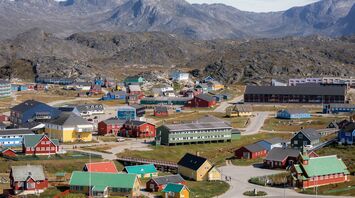Discover Greenland’s Stunning Trail of Inuit and Viking Farming Traditions

Ninety percent of visitors to Greenland only catch a fleeting glimpse of this nation. However, travelers who stay longer can explore cobalt fjords, verdant pastures, and well-preserved Viking ruins. Most visitors rarely experience South Greenland beyond its iceberg-dotted fjords and rugged mountains, often whisked away by cruise ships after brief visits. But for those with more time, Greenland’s sheep-farm backpacking routes offer a unique glimpse into the region where modern Inuit communities continue Viking farming traditions dating back to the 10th century.
Travelers can hike through nearly 40 sheep farms, with nine offering cozy overnight accommodations within the 134-square-mile UNESCO World Heritage site of Kujataa. With new flight routes and an international airport opening soon in Nuuk, visitors will have greater access to these immersive farm-to-farm hikes that support local communities and provide a profound connection to this remote landscape.
Greenland’s Answer to Hut-to-Hut Hiking
South Greenland’s agricultural roots date back to around 985 C.E. when Vikings brought livestock such as cows and sheep. Erik the Red, who named Greenland to attract settlers from Iceland, established Brattahlið, now Qassiarsuk, a key stop on today’s sheep-farm route. The Viking farming society thrived for nearly five centuries in this fertile subarctic land before mysteriously vanishing around the 15th century, possibly due to climate change.
In the late 1700s, Inuit communities revived agriculture in South Greenland, transforming it into an agribusiness hub. Today, travelers can hike past cobalt fjords, verdant pastures, and Viking ruins. The main backpacking route, linking five farm stays via four- to nine-mile hikes, starts in Qassiarsuk, near Narsarsuaq Airport. Here, you can begin your adventure at the Bed & Breakfast Illunnguujuk farm-stay, owned by the grandson of the village’s founder. Tour a reconstructed Viking longhouse and church before setting off on your journey.
Outfitters like woman-owned Travel by Heart help coordinate agri-trekking logistics, such as ferry transit from Narsarsuaq, reserving meals and beds, and planning trip durations ranging from a few days to a week. Blue Ice Explorer also offers an eight-day journey to four Qassiarsuk-area farms, followed by a ferry and agritourism overnight in Igaliku, a village that was once the religious center of Viking life.
From South Greenland’s largest town, Qaqortoq, reachable via regular ferry services from Narsarsuaq (and soon, a new airport anticipated to open in 2025), travelers can take a boat transfer halfway into Igaliku Fjord to reach accommodations such as cabins at Kangerluarsorujuk Sheep Farm and a hostel at Qanisartuut Sheep Farm. Backpacking between farms offers scenic, invigorating hikes, with hosts offering activities like horseback riding, ATV rides, and cultural gatherings known as kaffemik, featuring meals with local families.
"The best experiences for guests often come from eating in our home and talking to us," says Aviâja Lennert, who runs the icefjord-view Tasiusaq farm and its Sermilik Hostel alongside her husband, a third-generation farmer. The best time for hut-to-hut hiking in South Greenland is from June through September, when the weather is mild and the midnight sun provides extended daylight hours. September also offers the added bonus of witnessing sheep-herding activities and the northern lights.
A Shifting Agricultural Landscape
Sheep farming in Greenland has become less predictable due to climate change. In late October 2023, a surprise early snowstorm trapped many sheep, causing significant losses. Weather patterns such as long and heavy rains are also damaging grazing fields and hurting farmers economically.
From 2021 through 2023, sheep farmers across the North Atlantic, including those in Greenland, Norway, Scotland, Iceland, and the Faroe Islands, joined forces in a sustainable tourism program called Wool in the North. This initiative, funded by the Nordic Atlantic Cooperation (NORA), helped sheep farmers create wool-themed slow-tourism experiences centered on sustainability, art, textiles, and nature. These offerings will debut in 2024, featuring trips such as a 10-day culture and crafting journey through the Faroe Islands and textile-inspired excursions through North Iceland.
South Greenland has much to celebrate this year, with new wool tourism developments and the 100th anniversary of Qassiarsuk’s founding. The anniversary will bring concerts, exhibitions, and storytelling to the village all summer, making it an exciting time to visit this unique region.



















